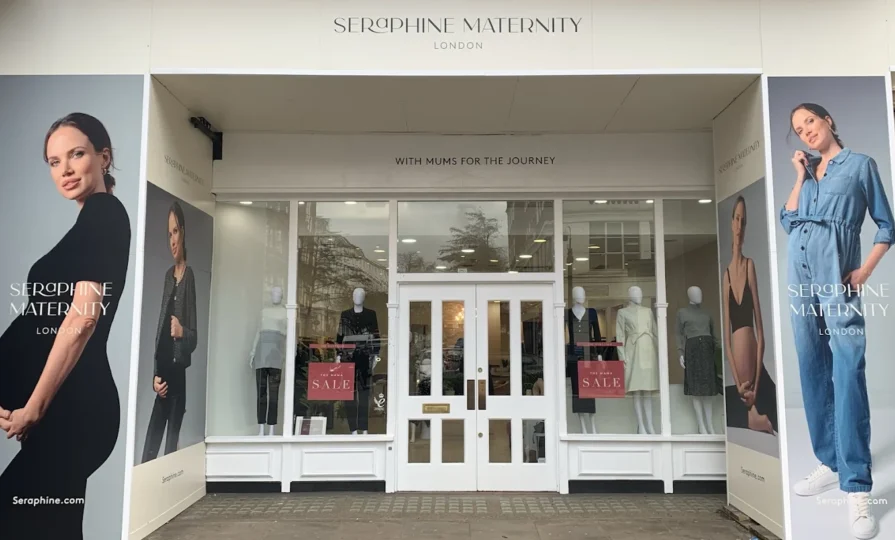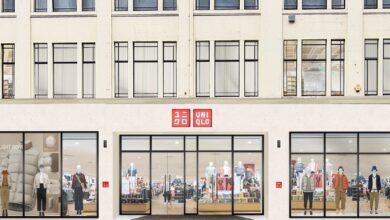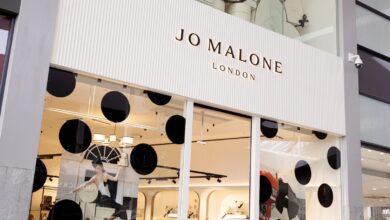From darling to downfall: what went wrong at Seraphine
Once the royal favourite redefining maternity style, Seraphine has since fallen on hard times. Does its tale expose the fragility of niche fashion in flux. Experts point to a rebrand that broke trust, a market that’s fundamentally changed, and a brand that, in the end, forgot the women it set out to serve

Register to get 1 more free article
Reveal the article below by registering for our email newsletter.
Want unlimited access? View Plans
Already have an account? Sign in
Seraphine, once the darling of maternity fashion, has collapsed into administration. Known for its stylish bump-friendly dresses and famously worn by the Princess of Wales during her pregnancies, the brand entered administration this July, shuttering operations and making most of its staff redundant. For a label that grew from a niche London startup in 2002 to a global name stocked by John Lewis and Next, the collapse raises urgent questions. Not just about what went wrong at Seraphine, but about the state of niche fashion in 2025.
Founded by Cecile Reinaud, Seraphine was born with a clear purpose: to offer stylish, high-quality maternity clothing in a category long dominated by beige basics and ill-fitting essentials. Its early success rested on clarity and charm,with the added bonus that the clothing was chic and the tone confident. The brand filled a market gap with its offering.
Royal endorsements later elevated the brand’s global profile. When Kate Middleton stepped out in a Seraphine dress in 2015, and then later once again in 2018, sales surged. It was the kind of publicity money couldn’t buy, and at the time, the brand rode the wave smartly, expanding its footprint online and overseas.
In 2020, Mayfair Equity Partners acquired Seraphine from Bridgepoint Growth and founder Cécile Reinaud, and a year later managed to float on the London Stock Exchange. Looking at the timeline, deals at the brand cycled fast because just two years later, in January 2023, it was taken private again by Mayfair for £15.3m. That move meant a delisting from the stock exchange and the kind of pressures brought on by private equity backing: to grow fast, optimise margins, and return profits quickly.
As Vineta Bajaj, ex-Ocado CFO and Rohlik Group finance lead, explains, “Rapid expansion combined with high marketing spend put significant pressure on cashflow, especially when consumer spending slowed down. In Seraphine’s case, the transition from public to private ownership also brought shifts in strategic priorities. Private equity owners often push for aggressive growth and cost-cutting, which can sometimes undermine long-term brand building if not carefully managed.”
Meanwhile, consumer confidence was dropping, supply chains tightening, and maternitywear itself shifting in meaning. In its final months, Seraphine launched a rebrand that introduced a new logo, a website overhaul, as well as a steep 60% off sale. The aim of the rebrand was to emphasise authenticity, thoughtful consumption and women’s retention of personal style during pregnancy. The rebrand only lasted a matter of months before Seraphine shut down operations in July, with Interpath Advisory appointed to assess the brand’s future and manage claims for redundant staff.
If Seraphine had one more shot, it was the April relaunch, but given the outcome, it appears that the rebrand fell flat. Kevin Baldwin, founder of clothing brand Wedding Tropics, is of the opinion that the rebrand actively accelerated the brand’s decline. Experts are of one mind on this: the new aesthetic lacked clarity and alienated core customers.
Rather than rethinking the product, price or positioning, the rebrand leaned into surface-level aesthetics. While the creative looked modern, there was no real narrative shift or offer innovation – no new reason for customers to care.
“Seraphine had strong brand equity and recognition, especially with high-profile endorsements, but the timing and execution of the rebrand seem to have caused more confusion than clarity. It moved away from its original British identity, which had made it distinctive, and leaned too heavily into a more generic, Scandinavian aesthetic,” Baldwin says. “For a maternitywear brand, trust and familiarity are key, especially when targeting a consumer base dealing with one of the most personal and vulnerable life stages. Shifting tone and design language without a clear explanation risks alienating loyal customers without attracting enough new ones to fill the gap.”
Kat Patterson, managing director of Art of the Possible, agrees with this assessment, adding, “Seraphine’s original strength was its specialist status – a stylish alternative in a function-first category. But as more brands entered the maternity wear space (from Asos to H&M and even athleisure brands), Seraphine failed to double down on its niche or expand it meaningfully. Rather than rethinking the product, price or positioning, the rebrand leaned into surface-level aesthetics. While the creative looked modern, there was no real narrative shift or offer innovation – no new reason for customers to care. For a demographic that shops with both head and heart, this rebrand lacked emotional and practical resonance.”
Meanwhile, Aaron Shields, executive director of experience strategy at Landor, put it sharply, “Seraphine didn’t die from a lack of demand. It died from emotional disconnection. In a category built on trust, it lost the feeling that held it all together. The private equity shenanigans had their part to play, but with proper brand management, Seraphine could’ve kept winning with this hard-to-reach audience.”
While maternitywear hasn’t vanished, it has transformed in the 23 years Seraphine has been active. Emma Ellis, president Interbrand London, believes it has never been more difficult for specialist brands to stand out given that they must compete with maternity lines from the likes of H&M or Shein. Beyond buying brand new, she points to another disrupter: “Consumer trends have shifted noticeably towards pre-owned models. Platforms such as Vinted and eBay make it easier than ever for parents to buy and sell second-hand maternity clothes. The cost of living crisis has also influenced spending behaviour. Given that maternity clothes often last only six months, many families find it difficult to justify the high price tag, especially if more affordable options are available.”
Patterson, who emphasises the unique challenge of the category’s inherent limitations, adds, “Maternity wear is inherently time-limited, and many women are now looking to borrow, rent, or buy versatile pieces they can wear before, during, and after pregnancy. Combine that with the cost-of-living crisis, and full-price maternity fashion becomes an increasingly tough sell – unless you’re solving a very clear problem or offering standout value.”
Demographics compound these pressures. Only 591,072 babies were born in the UK in 2023, the lowest figure since 1977, according to the Office for National Statistics – a figure unlikely to reverse soon.
As Bajaj noted earlier, private equity involvement as a rule focuses on short-to-medium term returns which can sideline brand storytelling for financial engineering.
Yet, as Baldwin reminded, the opportunity remains for brands that carve clear distinction. “Maternitywear often feels like an afterthought in broader fashion retail, so specialist brands do have a role, but only if they remain clear on who they’re for and why they’re different.” he says. “Seraphine’s story is a reminder that relevance and identity matter just as much as reach.”
Seraphine’s return to private ownership in 2023 brought typical private equity pressures: rapid growth targets, cost-cutting, and a focus on short-term returns. As Bajaj noted earlier, private equity involvement as a rule focuses on short-to-medium term returns which can sideline brand storytelling for financial engineering.
“In hindsight, the downfall might have been mitigated by a more cautious growth strategy, better cash management, and a clear, more consistent brand identity,” Bajaj speculates. “But the reality is that many retail businesses are navigating unprecedented economic pressures and shifting consumer behaviours, making survival increasingly tough without strong operational resilience.”
Shields has his own thoughts on the precarious nature of maternitywear as a business, saying, “Maternitywear is a niche within a niche. That’s a brutal tension for any retail model, especially with rising customer acquisition costs. If your promise isn’t crystal clear – or you fail to keep it – you become forgettable.”
Without a consistent brand custodian and the time to build loyalty, PE-backed labels often risk undermining the very identity that once made them valuable. Seraphine’s story is both a warning and a guide. According to Baldwin’s reflections on the brand’s collapse, this case highlights the fragility of even the most well-established fashion brands when growth outpaces demand and brand identity becomes diluted. “Many are overly reliant on paid digital ads and lack the flexibility to scale back quickly when sales soften,” he adds.
Experts largely don’t chalk Seraphine’s collapse to the death of maternitywear. Rather, it failed because it lost the feeling that made it matter.
Patterson, who points to emerging winners in the category, agrees, saying, “The success of niche disruptors and gender-inclusive parenting brands shows there is appetite for thoughtful, flexible design. But growth here requires deep customer empathy, not just range extensions. The next winning brand will likely blend smart, wearable products with lifestyle positioning and community-led engagement.”
In the end, narrow focus and deep connection beat broad but shallow reach. Niche fashion brands thrive by knowing their audience intimately and serving them fully. Experts largely don’t chalk Seraphine’s collapse to the death of maternitywear. Rather, it failed because it lost the feeling that made it matter. It went quiet on the very audience that once swore by it and forgot the emotional work of building trust, and traded that for growth at pace.
There are lessons here for every niche fashion brand: clarity beats trend; consistency beats noise; empathy beats scale. Seraphine promised to make mothers feel like themselves again. In the end, the brand itself changed too much and the customers, quietly, moved on.
For all the brands that hope to fill Seraphine’s shoes in the future, Ellis urges them to stay agile, saying, “It is clear that the landscape is more competitive than ever, and brands must be attuned to evolving consumer expectations to prosper.”







